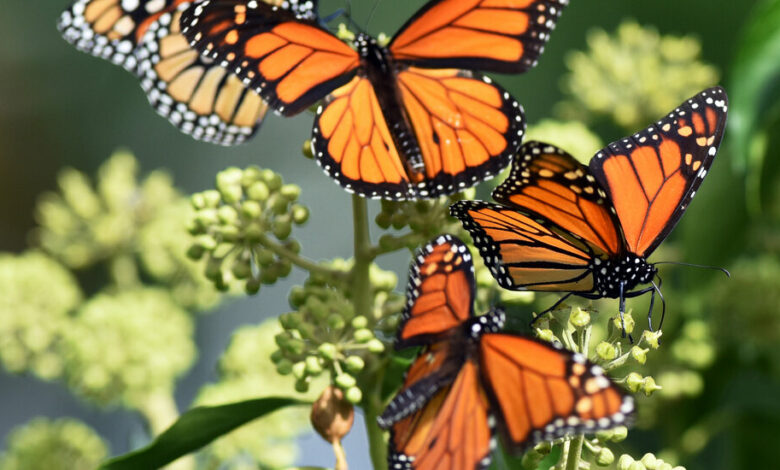New ‘detective work’ on butterfly deaths reveals prime suspect

What is the cause of the impending decline in insects?
Although more and more research shows that many insect populations are declining, it is difficult for scientists to determine the possible causes. Do insects suffer from habitat loss because natural areas are plowed and asphalted? Are they killing it from climate change? And what about pesticides?
The latest insight comes from a study of butterflies in the Midwest, published on Thursday in the journal PLOS ONEThe results do not discount the serious effects of climate change and habitat loss on butterflies and other insects, but they indicate that agricultural insecticides had the greatest impact on the size and diversity of butterfly populations in the Midwest during the study period, 1998 to 2014.
Particularly harmful, the researchers found, was a class of commonly used insecticides called neonicotinoids, which are taken up into the tissues of plants.
“It’s a story of unintended consequences,” said Scott Swinton, a professor of agricultural economics at Michigan State University and one of the study’s authors. “In developing technologies that were very effective at controlling soybean aphids and certain other agricultural pests, nontarget species that we care about, particularly butterflies, were harmed.”
Europe largely banned neonicotinoids in 2018 because of the risks to bees. The new findings come as wildlife officials in the United States debate whether monarch butterflies, which range from coast to coast, should be listed as endangered. (They have already found that such protections are warranted, but said higher-priority needs ruled them out.)
In addition to delighting humans and pollinating plants, butterfly species are an important food source for other animals, especially birds, during their caterpillar life stage. In fact, research has shown a link between the decline of some birds and the decline of insects.
For the new study, researchers integrated multiple data sets and used statistical analyzes to make comparisons between different potential causes of decline in 81 counties in five states. They found that pesticides in the average county over the 17-year study period were associated with an 8 percent decline in butterfly numbers, compared to a scenario in which pesticide use remained unchanged over the same period. For monarchs, the relative decline was as much as 33 percent.
The authors note that this pesticide-related decline began in 2003, coinciding with the emergence and rapid adoption of corn and soybean seeds treated with neonicotinoids in the Midwest.
Matt Forister, an insect ecologist at the University of Nevada, Reno, who was not involved in the study, praised the authors for their “detective work” and for the number of factors they included in the analysis: six groups of pesticides, climate change and changes in land use. He said the findings from the neonicotinoid study could be crucial in helping to tackle the decline of the butterfly population.
“We often talk about, well, it’s all the stressors of the Anthropocene, it’s all piling up, it’s all bad,” Dr. Forister said. “But when we see one specific thing that’s bad, no matter how bad it looked in the early 2000s, that’s actually hopeful because it means you can make different choices.”
Previous research by Dr. Forister showed that climate change has played a major role in the decline of the butterfly population in the American WestThe authors of the new study were careful to note that they could not evaluate the recent impact of climate change because they had to end their study period in 2014; after that year, data on neonicotinoid use were no longer available, so they could no longer make comparisons.
“The last 10 years have been the warmest 10 years on record,” said Leslie Ries, one of the authors and a professor of ecology at Georgetown University. “So what is the impact of the last 10 years? We need to continue to study that, but it’s hard to study it in its entirety without neonicotinoid data.”
The Environmental Protection Agency did not respond to questions seeking comment on the study and clarification on the status of neonicotinoids in the United States.
Climate change is not the only factor that seemed less important in this study than it might be in a broader sense. Another example is something that happened before the study period: the momentous shift in land use from natural ecosystems to industrial agriculture.
And in a result that may seem surprising, the study found no decline in monarch numbers due to the use of glyphosate, a herbicide commonly sold under the brand name Roundup. Glyphosate eradicates all types of weeds, including milkweed, the only food source for monarch caterpillars, and its use is widely considered a cause of the monarch’s overall decline. The authors do not dispute that consensus; rather, they say that glyphosate’s impact from the early 2000s has “largely disappeared since the largest decline in milkweed had already occurred.”
“That damage has been done and it continues to leave monarch butterflies in lower populations than in the past,” said Dr. Ries. “But it doesn’t explain the decline or changes over that 17-year period.”




